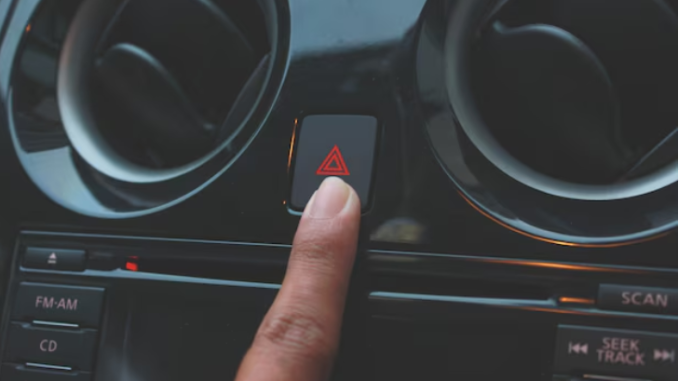
Deer activity increases dramatically from October to December, especially during the mating season. During these months, drivers often find themselves facing unexpected encounters on roads and highways. With deer crossing more frequently at dawn and dusk, the likelihood of accidents rises sharply. Whether driving through rural backroads or wooded highways, it’s crucial to stay alert and know exactly what to do if a deer suddenly jumps into your path.
Although hitting a deer can be frightening, staying calm and taking the right steps immediately can make a major difference. Joshua Branch, Founder and Personal Injury Attorney at the Law Offices of Joshua W. Branch, emphasizes that quick, thoughtful action protects both drivers and the animals involved.
1. Pull Over Safely and Turn On Hazard Lights
Freepik | EyeEm | If you hit a deer, move off the road and turn on your hazards right away.
The first step after hitting a deer is to pull over to a safe location. Even if the impact seems minor, stopping right away helps prevent further danger.
“Whether you spotted the deer too late or it appeared out of nowhere, move your vehicle to the shoulder and switch on your hazard lights,” Branch advises. “Doing this keeps you visible to other drivers, especially when it’s dark or foggy.”
Before stepping out, check for oncoming traffic. Remaining aware of your surroundings ensures you stay out of harm’s way while assessing the situation.
2. Stay Calm and Think Clearly
Hitting a deer is shocking for anyone, but keeping a clear head is essential. Panic often leads to poor decisions. Branch notes that staying calm allows you to properly evaluate any injuries or damage.
He explains, “When drivers remain composed, they’re able to handle the situation safely. Avoid standing in traffic lanes and move carefully if you leave your car.”
Taking deep breaths and observing your environment calmly can help you stay in control until help arrives.
3. Check on the Deer from a Distance
Many drivers instinctively want to check on the animal, but caution is key. While deer often seem docile, they can behave unpredictably after an accident.
Branch explains, “A deer that’s injured or in shock might kick or thrash suddenly. It’s safer to keep a distance and avoid touching it.”
If the deer appears severely injured or blocking traffic, contact local animal control or wildlife services. They have the proper training and equipment to handle the situation humanely and safely.
4. Call for Help and Report the Accident
After checking that you’re safe, make the necessary calls. Depending on the severity of the accident, notify the police, your insurance provider, or animal control.
Branch suggests, “If the deer runs off but your vehicle is damaged or you’re injured, contact 911. Some states legally require you to report certain types of accidents, especially when there’s major property damage or personal injury.”
If your car is undrivable, turn on hazard lights and wait for roadside assistance in a secure spot. Avoid standing between lanes or behind your vehicle.
Ways to Reduce the Risk of Hitting a Deer
While not every accident can be avoided, some driving habits can lower the chances of hitting a deer. Awareness and prevention go a long way, especially during peak deer movement months.
1. Reduce Your Speed in High-Risk Areas
Speed plays a major role in accident severity. Slowing down through wooded areas or roads marked with deer crossing signs gives you more time to react.
“Deer are most active during dawn and dusk,” says Branch. “If you’re driving through areas where deer are common, especially near creeks or forests, lowering your speed can minimize potential damage and keep everyone safer.”
Even a small reduction in speed can drastically change the outcome of an unexpected encounter.
2. Use High Beams When Safe
Freepik | lucegrafiar | Use your high beams wisely to spot deer early and stay safe on the road.
Good visibility is one of your best defenses. When driving at night, use your high beams whenever possible—just remember to dim them for oncoming traffic.
According to Branch, “Bright beams help you spot a deer’s reflective eyes from a distance. But if a deer suddenly appears, never swerve sharply. That move can lead to a far more serious crash.”
Instead, brake firmly and keep control of your vehicle. Maintaining a straight path usually results in less severe damage than swerving off the road or into another lane.
3. Stay Alert and Avoid Distractions
Distraction is one of the biggest factors in animal-related accidents. Whether adjusting the radio, checking a GPS, or reaching for a drink, a momentary lapse in attention can be dangerous.
“Deer rarely travel alone,” Branch explains. “If one crosses, more are likely following close behind. Stay alert and ready to slow down if you spot one nearby.”
Keeping both hands on the wheel, eyes on the road, and mind focused significantly lowers risk—especially in areas with dense vegetation where animals can appear suddenly.
Deer collisions can happen instantly, but preparation makes all the difference. Knowing how to respond helps reduce panic and damage. From slowing down and using high beams to contacting authorities, each step promotes safer roads.
Awareness and calm action protect both drivers and wildlife. Accidents are unpredictable, but preparation and caution turn a stressful moment into a manageable one.
The post What to Do If You Hit a Deer While Driving — Safety Guide appeared first on Cash Roadster.
